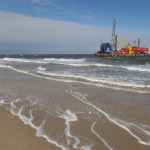
Delphine Batho, French Minister for Ecology
The French minister for ecology has promised her government will set down stable rules for renewable energies as the wind industry demands action to save it from the “critical” state is has been in since May when France’s highest administrative court, the Council of State, asked the European Court of Justice (ECJ) to rule whether the country’s premium purchase price for onshore wind constituted state aid.
“We will define stable rules for renewable energies for the duration of the government’s five-year mandate,” says Delphine Batho in the September issue of the French sustainable development magazine Terra Eco. She admits that “in the past few years, the incessant changes to rules, purchase prices, moratoriums etc., have profoundly destabilised” the industry. These “rules” are expected to be discussed at a conference on the environment to be hosted by the government on 14-15 September.

By Megan Swieca
Offshore renewable energies are expanding to meet the EU’s 2020 renewable energy targets, but renewables are one of many activities competing for space at sea. Meanwhile, Europe’s maritime nations are currently operating under their own planning rules and guidelines, which often conflict with their neighbours and waste time and money.
This was the focus of a two year project, funded by the European Commission’s Intelligent Energy Europe programme and coordinated by EWEA, entitled SEANERGY 2020. The main findings and policy recommendations of the project were presented at a final workshop as part of the European Union Sustainable Energy Week.
 Today’s turbines can be mind-bogglingly big, but big is not necessarily better. Mike Woebbeking, Vice President of GL group and chair of a session at EWEA 2012 in Copenhagen on 16 April that delves into turbine size, tells the EWEA blog that size isn’t everything…
Today’s turbines can be mind-bogglingly big, but big is not necessarily better. Mike Woebbeking, Vice President of GL group and chair of a session at EWEA 2012 in Copenhagen on 16 April that delves into turbine size, tells the EWEA blog that size isn’t everything…
How has the average turbine size changed over the last decade?
Ten years ago the average size was around 1.5 MW, today it is close to 3 MW. Thus the average size of onshore wind turbines more or less doubled. For offshore wind this is more difficult to say. A decade ago there were only very few turbines installed offshore. The average size could be assumed to be around 1.5 MW. Today the average offshore turbine size is below 5 MW, however 7 MW turbines and bigger are under development. The average size of offshore turbines has roughly tripled within a decade.

P.N.Rasmussen
According to former Danish prime minister Poul Nyrup Rasmussen, the offshore wind energy sector could help Europe get back on its feet after the current financial crisis. “If the sector understands their role I’m sure they could take the lead in bringing Europe out of the crisis, as the first mover”, he added in a recent interview with Wind Directions.
He even considered the sector’s biggest challenge in the next few years to be addressing its potential role as “the breaker in the markets going against the [financial] crisis.” As a Dane and a former politician, Rasmussen is no stranger to wind energy. Now, he has consolidated his familiarity with the sector as Chairman of Lindoe Offshore Renewables Centre (LORC), a Danish organisation that tests and demonstrates technologies for harvesting renewable energy offshore.
 Every day newspapers are full of the latest Eurozone crisis. In 2010, Tom Murley from private equity firm HgCapital described the economy to Wind Directions as having had the equivalent of “open-heart surgery”. Today, he says: “Depending on what happens with the Eurozone we may be wheeling the economy back into surgery again.”
Every day newspapers are full of the latest Eurozone crisis. In 2010, Tom Murley from private equity firm HgCapital described the economy to Wind Directions as having had the equivalent of “open-heart surgery”. Today, he says: “Depending on what happens with the Eurozone we may be wheeling the economy back into surgery again.”
The offshore wind energy industry is particularly vulnerable to the current squeeze. Banks are now having to pay more for the long-term loans the sector requires, so they are becoming more reluctant to offer them.








 Comments
Comments



